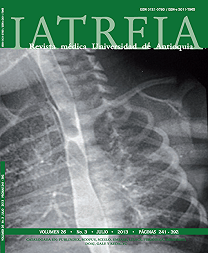Lung paragonimiais in children: Report of two cases
DOI:
https://doi.org/10.17533/udea.iatreia.14384Keywords:
Eosinofilia, Paragonimiasis, Praziquantel, TriclabendazolAbstract
Paragonimiasis is a parasitic zoonosis, food-borne trematodes caused by species of the genus Paragonimus, found in tropical and subtropical areas of Asia, Africa and America. Humans become infected by eating raw or undercooked freshwater shellfish. The infection primarily affects the lungs, development of multiple clinical and radiological manifestations, depending on what the parasite's life cycle is. The most important differential diagnosis of this disease is pulmonary tuberculosis.
This article describes the disease in two girls with different pulmonary manifestations. The paragonimiasis should be suspected in patients with chronic cough, rusty sputum, chest pain, with or without brain involvement, who live or have lived in an endemic area and having a high eosinophilia with radiographic changes suggestive of Loeffler's syndrome.
Downloads
Downloads
Published
How to Cite
Issue
Section
License
Papers published in the journal are available for use under the Creative Commons license, specifically Attribution-NonCommercial-ShareAlike 4.0 International.
The papers must be unpublished and sent exclusively to the Journal Iatreia; the author uploading the contribution is required to submit two fully completed formats: article submission and authorship responsibility.














